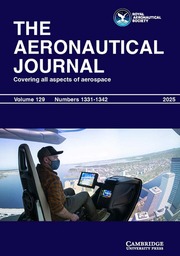Crossref Citations
This article has been cited by the following publications. This list is generated based on data provided by
Crossref.
Ashill, P. R.
Fulker, J. L.
and
Hackett, K. C.
2005.
A review of recent developments in flow control.
The Aeronautical Journal,
Vol. 109,
Issue. 1095,
p.
205.
Garcillan, Luis
Liddle, Stephen
Sunneechurra, Kailash
Crowther, Bill
Zhong, Shan
and
Wood, Norman
2006.
PIV Measurements of the Effect of Pitch and Skew on a Circular Orifice Synthetic Jet in a Turbulent Boundary Layer.
Lockerby, Duncan A.
Carpenter, Peter W.
and
Davies, Christopher
2007.
Is Helmholtz Resonance a Problem for Micro-jet Actuators?.
Flow, Turbulence and Combustion,
Vol. 78,
Issue. 3-4,
p.
205.
Timor, Itay
Ben-Hamou, Eli
Guy, Yair
and
Seifert, Avi
2007.
Maneuvering Aspects and 3D Effects of Active Airfoil Flow Control.
Flow, Turbulence and Combustion,
Vol. 78,
Issue. 3-4,
p.
429.
Kudar, K. L.
and
Carpenter, P. W.
2007.
Numerical Investigation and Feasibility Study of a PZT-driven Micro-valve Pulsed-jet Actuator.
Flow, Turbulence and Combustion,
Vol. 78,
Issue. 3-4,
p.
223.
Glezer, Ari
2011.
Some aspects of aerodynamic flow control using synthetic-jet actuation.
Philosophical Transactions of the Royal Society A: Mathematical, Physical and Engineering Sciences,
Vol. 369,
Issue. 1940,
p.
1476.
Crowther, W J
Jabbal, M
and
Liddle, S C
2011.
Flow Control Fallacies: A Review of Commonpitfalls in Flow Control Research.
Proceedings of the Institution of Mechanical Engineers, Part G: Journal of Aerospace Engineering,
Vol. 225,
Issue. 1,
p.
1.
Lee, A.
Yeoh, G.H.
Timchenko, V.
and
Reizes, J.A.
2012.
Flow structure generated by two synthetic jets in a channel: Effect of phase and frequency.
Sensors and Actuators A: Physical,
Vol. 184,
Issue. ,
p.
98.
Wen, Xin
Tang, Hui
and
Duan, Fei
2015.
Vortex dynamics of in-line twin synthetic jets in a laminar boundary layer.
Physics of Fluids,
Vol. 27,
Issue. 8,
Wen, Xin
Tang, Hui
and
Duan, Fei
2016.
Interaction of in-line twin synthetic jets with a separated flow.
Physics of Fluids,
Vol. 28,
Issue. 4,
Wen, Xin
and
Tang, Hui
2016.
Effect of phase difference on the interaction of hairpin vortices induced by in-line twin synthetic jets.
Journal of Visualization,
Vol. 19,
Issue. 1,
p.
79.
Wen, Xin
Tang, Hui
and
Liu, Yingzheng
2018.
Interaction of twin synthetic jets in attached and separated boundary layers: effects of yaw angle and phase difference.
Journal of Visualization,
Vol. 21,
Issue. 6,
p.
949.
Wang, Hongxin
Xu, Degang
Li, Linwen
Zhou, Kaiwen
Wen, Xin
and
Tang, Hui
2022.
Evolution and Near-Wall Effect of the Vortex Structures Induced by In-Line Twin Synthetic Jets in a Crossflow.
Actuators,
Vol. 11,
Issue. 8,
p.
234.
Ja'fari, Mohammad
Shojae, Fardin J.
and
Jaworski, Artur J.
2023.
Synthetic jet actuators: Overview and applications.
International Journal of Thermofluids,
Vol. 20,
Issue. ,
p.
100438.
Bharghava, D. Sai Naga
Jana, Tamal
and
Kaushik, Mrinal
2024.
A survey on synthetic jets as active flow control.
Aerospace Systems,
Vol. 7,
Issue. 3,
p.
435.
Ho, Howard H.
Shirinzad, Ali
Essel, Ebenezer E.
and
Sullivan, Pierre E.
2024.
Synthetic Jet Actuators for Active Flow Control: A Review.
Fluids,
Vol. 9,
Issue. 12,
p.
290.

